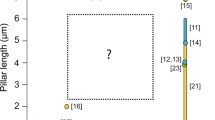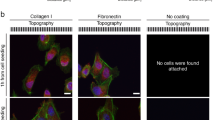Abstract
Cell migration is facilitated by the interaction of living cells and their local microenvironment. The local topography is one of the key factors regulating cell migration. Interaction between the surface topography and the cell behaviors is critical to understanding tissue development and regeneration. In this study, a dynamic mask photolithography technique has been utilized to fabricate a surface with graded micropillars. It has been demonstrated that the cells have been successfully guided to migrate from the sparse zone to the dense zone. The cell polarization angle has been characterized in both sparse zone and the dense zone. Compared to the dense zone, the cells in the sparse zone are more aligned along the direction of the micropillar spacing gradient, which enables the guided cell migration. Moreover, the effects of the micropillar spacing gradient, micropillar diameter, and micropillar height have been investigated in terms of the cell migration speed and cell spreading area. Finally, two issues significantly affecting the cell migration have been discussed: trapped cells between the micropillars and cell clusters.










Similar content being viewed by others
References
Lara Rodriguez L, Schneider IC (2013) Directed cell migration in multi-cue environments. Integr Biol 5(11):1306–1323
Painter KJ (2009) Continuous models for cell migration in tissues and applications to cell sorting via differential chemotaxis. Bull Math Biol 71(5):1117
Nie F-Q, Yamada M, Kobayashi J, Yamato M, Kikuchi A, Okano T (2007) On-chip cell migration assay using microfluidic channels. Biomaterials 28(27):4017–4022
Rennekampff H-O, Hansbrough JF, Kiessig V, Doré C, Sticherling M, Schröder J-M (2000) Bioactive interleukin-8 is expressed in wounds and enhances wound healing. J Surg Res 93(1):41–54
Berthier E, Surfus J, Verbsky J, Huttenlocher A, Beebe D (2010) An arrayed high-content chemotaxis assay for patient diagnosis. Integr Biol 2(11–12):630–638
Feng JF, Liu J, Zhang XZ, Zhang L, Jiang JY, Nolta J, Zhao M (2012) Guided migration of neural stem cells derived from human embryonic stem cells by an electric field. Stem Cells 30(2):349–355
Jacquemet G, Hamidi H, Ivaska J (2015) Filopodia in cell adhesion, 3D migration and cancer cell invasion. Curr Opin Cell Biol 36:23–31
Albuschies J, Vogel V (2013) The role of filopodia in the recognition of nanotopographies. Sci Rep 3:1658
Prager-Khoutorsky M, Goncharov I, Rabinkov A, Mirelman D, Geiger B, Bershadsky AD (2007) Allicin inhibits cell polarization, migration and division via its direct effect on microtubules. Cell Motil Cytoskelet 64(5):321–337
Devreotes P, Janetopoulos C (2003) Eukaryotic chemotaxis: distinctions between directional sensing and polarization. J Biol Chem 278(23):20445–20448
McCarthy JB, Furcht LT (1984) Laminin and fibronectin promote the haptotactic migration of B16 mouse melanoma cells in vitro. J Cell Biol 98(4):1474–1480
Lo C-M, Wang H-B, Dembo M, Wang Y-L (2000) Cell movement is guided by the rigidity of the substrate. Biophys J 79(1):144–152
Mycielska ME, Djamgoz MB (2004) Cellular mechanisms of direct-current electric field effects: galvanotaxis and metastatic disease. J Cell Sci 117(9):1631–1639
Park J, Kim D-H, Levchenko A (2018) Topotaxis: a new mechanism of directed cell migration in topographic ECM gradients. Biophys J 114(6):1257–1263
Kim D-H, Han K, Gupta K, Kwon KW, Suh K-Y, Levchenko A (2009) Mechanosensitivity of fibroblast cell shape and movement to anisotropic substratum topography gradients. Biomaterials 30(29):5433–5444
Park J, Kim D-H, Kim H-N, Wang CJ, Kwak MK, Hur E, Suh K-Y, An SS, Levchenko A (2016) Directed migration of cancer cells guided by the graded texture of the underlying matrix. Nat Mater 15(7):792
Hui J, Pang SW (2019) Cell migration on microposts with surface coating and confinement. Biosci Rep 39(2):BSR20181596
Wei J, Shi J, Wang B, Tang Y, Tu X, Roy E, Ladoux B, Chen Y (2016) Fabrication of adjacent micropillar arrays with different heights for cell studies. Microelectron Eng 158:22–25
Alapan Y, Younesi M, Akkus O, Gurkan UA (2016) Anisotropically stiff 3D micropillar niche induces extraordinary cell alignment and elongation. Adv Healthc Mater 5(15):1884–1892
Kim D-H, Provenzano PP, Smith CL, Levchenko A (2012) Matrix nanotopography as a regulator of cell function. J Cell Biol 197(3):351–360
Beussman KM, Rodriguez ML, Leonard A, Taparia N, Thompson CR, Sniadecki NJ (2016) Micropost arrays for measuring stem cell-derived cardiomyocyte contractility. Methods 94:43–50
Bayley G, Mallon P (2008) Surface studies of corona treated polydimethylsiloxane-block-polystyrene hybrid copolymer films. Polym Eng Sci 48(10):1923–1930
**a W, Liu W, Cui L, Liu Y, Zhong W, Liu D, Wu J, Chua K, Cao Y (2004) Tissue engineering of cartilage with the use of chitosan-gelatin complex scaffolds. J Biomed Mater Res B Appl Biomater 71(2):373–380
Bodas D, Khan-Malek C (2007) Hydrophilization and hydrophobic recovery of PDMS by oxygen plasma and chemical treatment—an SEM investigation. Sens Actuators B Chem 123(1):368–373
Krishnamoorthy S, Noorani B, Xu C (2019) Effects of encapsulated cells on the physical–mechanical properties and microstructure of gelatin methacrylate hydrogels. Int J Mol Sci 20(20):5061
Wadnap S, Krishnamoorthy S, Zhang Z, Xu C (2019) Biofabrication of 3D cell-encapsulated tubular constructs using dynamic optical projection stereolithography. J Mater Sci Mater Med 30(3):36
Merceron TK, Burt M, Seol Y-J, Kang H-W, Lee SJ, Yoo JJ, Atala A (2015) A 3D bioprinted complex structure for engineering the muscle–tendon unit. Biofabrication 7(3):035003
Ridley AJ, Schwartz MA, Burridge K, Firtel RA, Ginsberg MH, Borisy G, Parsons JT, Horwitz AR (2003) Cell migration: integrating signals from front to back. Science 302(5651):1704–1709
Chen Z, Li Y, Liu W, Zhang D, Zhao Y, Yuan B, Jiang X (2009) Patterning mammalian cells for modeling three types of naturally occurring cell–cell interactions. Angew Chem Int Ed 48(44):8303–8305
Xu H, Casillas J, Xu C (2019) Effects of printing conditions on cell distribution within microspheres during inkjet-based bioprinting. AIP Adv 9(9):095055
Collins T (2007) ImageJ for Microscopy. BioTechniques 43:S25–S30
Saez A, Buguin A, Silberzan P, Ladoux B (2005) Is the mechanical activity of epithelial cells controlled by deformations or forces? Biophys J 89(6):L52–L54
Ghibaudo M, Saez A, Trichet L, Xayaphoummine A, Browaeys J, Silberzan P, Buguin A, Ladoux B (2008) Traction forces and rigidity sensing regulate cell functions. Soft Matter 4(9):1836–1843
Wu J, Mao Z, Tan H, Han L, Ren T, Gao C (2012) Gradient biomaterials and their influences on cell migration. Interface Focus 2(3):337–355
Doyle AD, Wang FW, Matsumoto K, Yamada KM (2009) One-dimensional topography underlies three-dimensional fibrillar cell migration. J Cell Biol 184(4):481–490
Huang Y-J, Samorajski J, Kreimer R, Searson PC (2013) The influence of electric field and confinement on cell motility. PLoS ONE 8(3):e59447
Ponti A, Machacek M, Gupton S, Waterman-Storer C, Danuser G (2004) Two distinct actin networks drive the protrusion of migrating cells. Science 305(5691):1782–1786
Tremel A, Cai A, Tirtaatmadja N, Hughes BD, Stevens GW, Landman KA, O’Connor AJ (2009) Cell migration and proliferation during monolayer formation and wound healing. Chem Eng Sci 64(2):247–253
Crouch AS, Miller D, Luebke KJ, Hu W (2009) Correlation of anisotropic cell behaviors with topographic aspect ratio. Biomaterials 30(8):1560–1567
Vernon RB, Gooden MD, Lara SL, Wight TN (2005) Microgrooved fibrillar collagen membranes as scaffolds for cell support and alignment. Biomaterials 26(16):3131–3140
Zhu P, Tseng N-H, **e T, Li N, Fitts-Sprague I, Peyton SR, Sun Y (2019) Biomechanical microenvironment regulates fusogenicity of breast cancer cells. ACS Biomater Sci Eng 5:3817–3827
Yang MT, Fu J, Wang Y-K, Desai RA, Chen CS (2011) Assaying stem cell mechanobiology on microfabricated elastomeric substrates with geometrically modulated rigidity. Nat Protoc 6(2):187–213
Zhang Y, Xu G, Lee RM, Zhu Z, Wu J, Liao S, Zhang G, Sun Y, Mogilner A, Losert W (2017) Collective cell migration has distinct directionality and speed dynamics. Cell Mol Life Sci 74(20):3841–3850
Rørth P (2009) Collective cell migration. Ann Rev Cell Dev 25:407–429
Trepat X, Chen Z, Jacobson K (2012) Cell migration. Compr Physiol 2(4):2369–2392
Trepat X, Wasserman MR, Angelini TE, Millet E, Weitz DA, Butler JP, Fredberg JJ (2009) Physical forces during collective cell migration. Nat Phys 5(6):426–430
Painter K (2009) Modelling cell migration strategies in the extracellular matrix. J Math Biol 58(4–5):511
Raeber G, Lutolf M, Hubbell J (2007) Mechanisms of 3-D migration and matrix remodeling of fibroblasts within artificial ECMs. Acta Biomater 3(5):615–629
Koh B, Jeon H, Kim D, Kang D, Kim KR (2019) Effect of fibroblast co-culture on the proliferation, viability and drug response of colon cancer cells. Oncol Lett 17(2):2409–2417
Endaya B, Guan SP, Newman JP, Huynh H, Sia KC, Chong ST, Kok CY, Chung AY, Liu BB, Hui KM (2017) Human mesenchymal stem cells preferentially migrate toward highly oncogenic human hepatocellular carcinoma cells with activated EpCAM signaling. Oncotarget 8(33):54629
Zhao X, Jain S, Larman HB, Gonzalez S, Irvine DJ (2005) Directed cell migration via chemoattractants released from degradable microspheres. Biomaterials 26(24):5048–5063
Acknowledgements
This work was partially supported by Texas Tech University start-up fund and National Natural Science Foundation of China (51709120).
Author information
Authors and Affiliations
Corresponding author
Ethics declarations
Conflict of interest
The authors declare that there is no conflict of interest.
Ethical approval
This study does not contain any studies with human or animal subjects performed by any of the authors.
Rights and permissions
About this article
Cite this article
Krishnamoorthy, S., Zhang, Z. & Xu, C. Guided cell migration on a graded micropillar substrate. Bio-des. Manuf. 3, 60–70 (2020). https://doi.org/10.1007/s42242-020-00059-7
Received:
Accepted:
Published:
Issue Date:
DOI: https://doi.org/10.1007/s42242-020-00059-7




